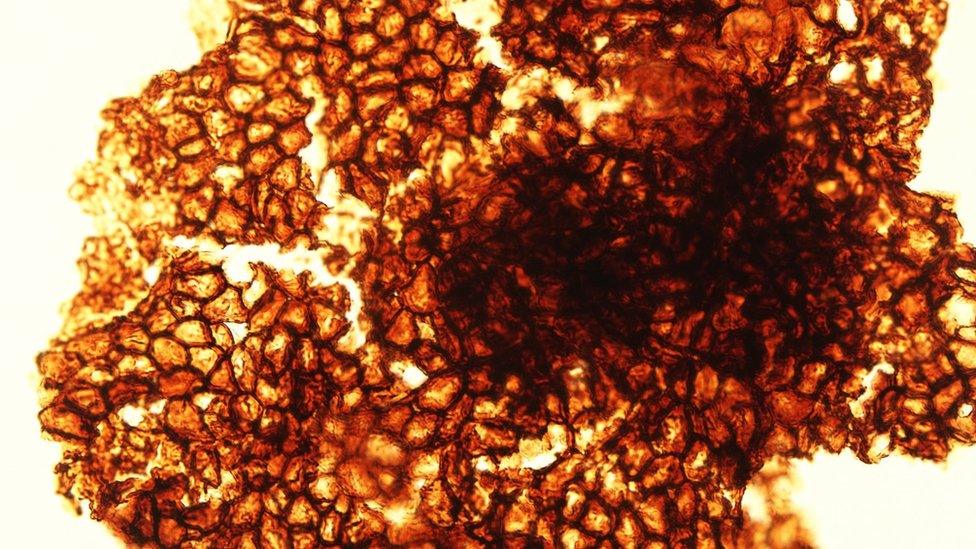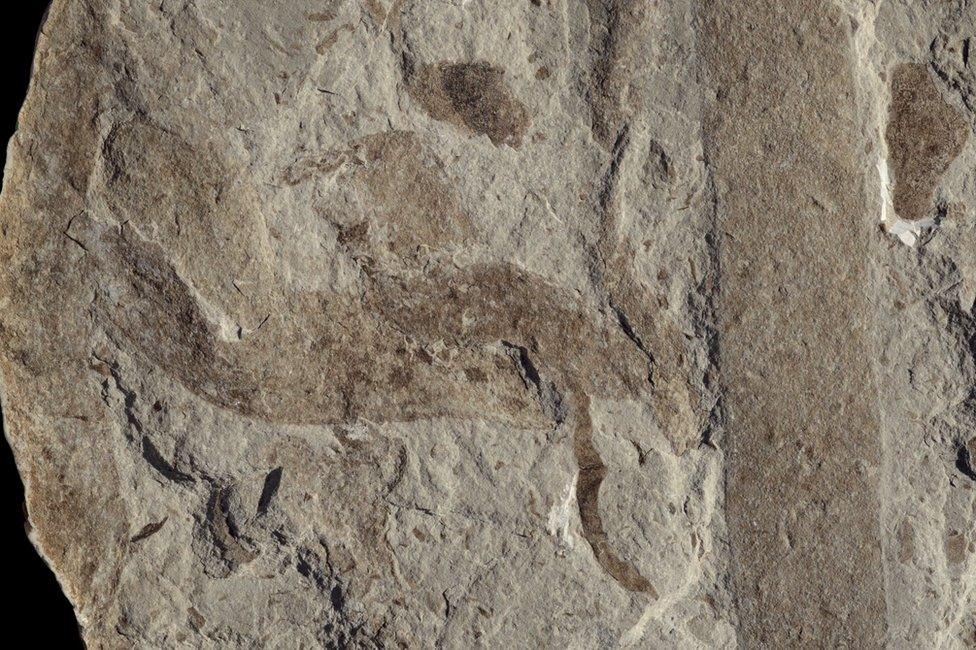Life forms 'went large' a billion years ago
- Published

Some of the fossils have well-preserved cellular structure
Life was already organising itself into large communities of cells more than a billion years ago, according to evidence from China.
The centimetre-scale life forms were preserved in mudstones from the Yanshan area in the country's north and are dated to 1.56 billion years ago.
Fossils big enough to be seen by the naked eye became common between 635 and 541 million years ago.
But the latest specimens are more than twice that age.
The findings by a Chinese-American team of researchers appear in the journal Nature Communications, external.
The mysterious organisms from the Gaoyuzhuang rock formation appear to belong to the branch of life known as the eukaryotes, which today includes everything from single-celled amoebae to plants, fungi and animals.
The sea-dwelling life forms probably lived on the shelf areas of ancient oceans and bear a superficial resemblance to algae. They also appear to have used photosynthesis, the process by which plants, some bacteria and other simple organisms convert sunlight into chemical energy.
Prof Andrew Knoll, from Harvard University, a co-author of the paper, said the organism represented by the Chinese fossils was "large but I doubt that it was complicated - an important distinction".
He told me: "You're a good example of a complex multi-cellular organism because you have 250 cell types, dozens of tissues, different organ systems.
"On the other hand if you go to the beach you will find seaweeds that consist of a sheet of cells that are almost all identical. Most of them can either photosynthesise or be used for reproduction."
The team, including Prof Knoll and Shixing Zhu from the China Geological Survey in Tianjin, found that life in this ancient period had already developed a variety of forms.
Of 53 separate specimens, 26 (49%) were linear in shape, 16 (30%) were wedge-shaped, eight (15%) were tongue-shaped and three (6%) were oblong-shaped.
The marine organisms measured up to 30cm in length and up to 8cm wide. Some of the specimens revealed fine structure: a closely-packed arrangement of individual cells measuring about 10 micrometres long - which is the same as the width of cotton fibre.
Go big or go home
Examples of multi-cellular life dating back more than a billion-and-a-half years have been described before. They include Horodyskia, which was shaped like a strings of beads, and Grypania, a coiled, ribbon-like organism.
But the diversity of forms and the size of the fossils from Yanshan mark them out.
The researchers say the fossils are unlikely to be of agglomerations of bacteria known as microbial mats, and instead are probably early examples of eukaryotic organisms.
If so, the organisms suggest multi-cellularity was a feature of marine life a billion years before the so-called Cambrian explosion, a rapid evolutionary event that began 542 million years ago and resulted in the divergence of major animal groups.
Some scientists partly attribute this evolutionary flowering to a rise in oxygen levels, although the causes are the matter of continuing debate.
The findings also suggest that the preceding era, characterised by lower oxygen levels and sometimes referred to as the "boring billion", may have been misjudged.

The rocks containing the fossils have been subjected to Uranium-Lead dating
Prof Knoll told BBC News: "It looks like the leap from single cells to simple multi-cellularity is easy - in relative terms. It was done many times (over the course of evolution) and this really cements the case that it was done early in the history of eukaryotes.
"There are a couple of cases where we know the genomes of both unicellular (single-celled) organisms and their closest multi-cellular relatives. When the jump is from a single cell to simple multi-cellularity, there's very little difference in the gene content of the organism. That's a small leap forward.
"The difference when you go from simple multi-cellularity to complex multi-cellularity, however, is large. The tree of life suggests that has happened only rarely."
However, the team was not able to link the fossils with any other known group of eukaryotes - living or extinct.

The unlikely beginnings of life on Earth

4.5 bn years ago, a young planet crashed into Earth - releasing iron from the Earth's core, which contributed to the chemical cocktail from which life emerged
Life may have arisen at hydrothermal vents - underwater hot springs dotted across the ocean floor

Follow Paul on Twitter., external